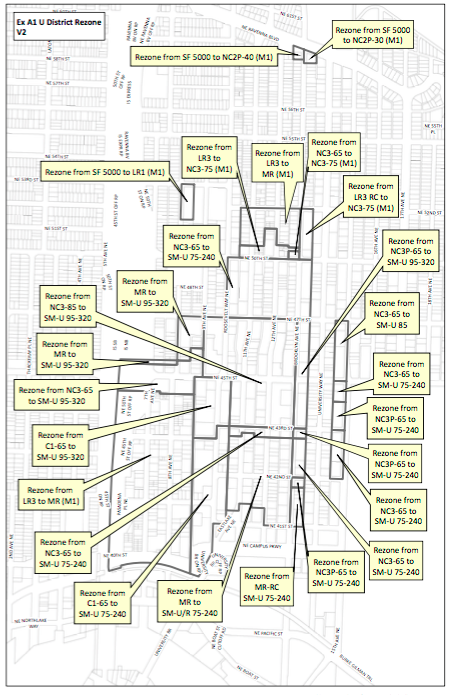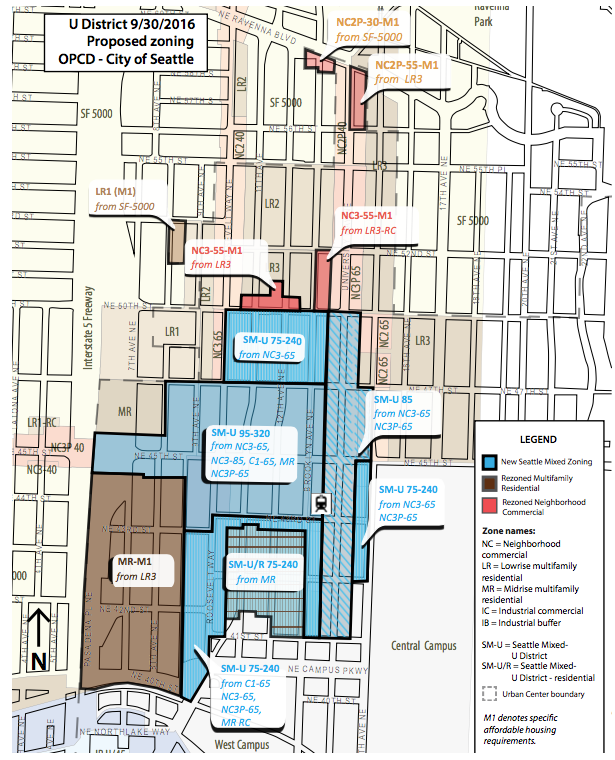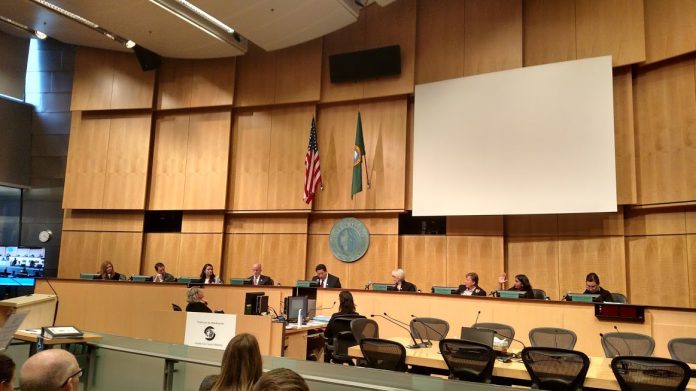New high-rises could be on the way for the University District (U District) for the first time since the 1970’s. In a significant unanimous vote yesterday, the Seattle City Council approved a neighborhood-wide rezone that could allow buildings as tall as 320 feet–at least in one pocket. Most of the rezone is much more tempered in maximum height limits, and it’s coupled with a suite of new development standards, increases in maximum floor area allowances for new development, and a requirement that most new commercial and multi-family residential development be paired with affordable housing.
Last-Minute Amendment Proposals
At the full Council meeting yesterday, four amendments were proposed to the final legislation. These included a clawback amendment for the rezones in case the MHA requirements were nullified by a court order, elimination of a rezone pocket north of NE 50th St, further increasing MHA requirements for the high-rise zones by one percentage point, and a provision for reviewing MHA progress.
- Councilmember Lisa Herbold proposed the clawback amendment, which would only be effective if MHA requirements are found unconstitutional by the courts. This would revert areas rezoned by the legislation back to their original zoning. The amendment succeeded on a 9-0 vote.
- Councilmember Herbold also proposed an amendment to remove a rezone pocket between NE 50th St and NE 52nd St slated to go to Midrise (MR) zoning. The amendment failed on a 3-6 vote (with Councilmembers Mike O’Brien, Lisa Herbold, and Kshama Sawant in the minority).
- Councilmember Mike O’Brien proposed an amendment to make a modest 1% increase in MHA requirements for the high-rise zones. The amendment sought to establish a 10% set-side requirement for affordable housing based upon total square footage and units or a fee of $22.25 per square foot, less any exemptions. The amendment failed on a 3-6 vote (with Councilmembers Mike O’Brien, Lisa Herbold, and Kshama Sawant in the minority).
- A fourth amendment signaled the Council’s intent to review the program yearly to determine how the MHA program was working and if elements need to be tweaked, such as increasing capacity or potentially upping the affordability requirements. The amendment passed 9-0.
Public Testimony
The City Council meeting included a full slot of public testimony with folks in opposition to the zoning changes donning neon scarves to mark themselves. Perhaps sensing the main legislation was bound to succeed, the Seattle Displacement Coalition (SDC) seemed to have their supporters focused on pushing Councilmember Herbold’s amendment to exclude an area between NE 50th St and NE 52nd St. They claimed 175 low-income homes were at risk, but we’ve covered the problem’s with SDC’s displacement math before. Many folks supporting the University District rezone and urban design legislation spoke, too, including The Urbanist‘s very own Owen Pickford. Ultimately, the meeting culminated in the City Council passing the proposal.
Here's the testimony of our Executive Director @pickovven. Pass the #HALA rezones. pic.twitter.com/Ydk5otU38k
— The Urbanist (@UrbanistOrg) February 21, 2017
Legislation Highlights

The University District legislation marks the first major batch of rezones to unlock Mandatory Housing Affordability (MHA) requirements. New multi-family residential and commercial developments will need to set-aside affordable housing or pay a fee to the City to construct affordable housing nearby. The highest rates for affordable housing requirements in the University District will be 9% set-aside requirement based upon residential units and commercial square footage; alternatively, developers can pay a fee of $20 per square foot, less any allowed exemptions. The Seattle Office of Planning and Development expects that between 620 and 910 affordable housing units will be developed in the University District through MHA’s developer requirements.
Maximum allowed building heights will range from 240 to 320 feet in the core area near a future light rail station opening in 2021. In other areas, maximum building heights will be more modest in the 40- to 95-foot range. Across the board, the rezones will come with increased floor area allowances to provide for more development density on sites. The degree to which maximum floor area allowances will change depends upon the existing and new zoning applicable to a property. Much of the new floor area allowances won’t be free, in part because of the new MHA requirements, but also because incentives will be required to use up extra floor area and height allowances beyond the base maximum otherwise allowed.
The Ave: Excluded For Now
One substantial change to the rezone, however, was the removal of The Ave (south of NE 50th St). The original legislation had included a zoning change to SM-U 85 zoning, which would have allowed 85-foot tall buildings with an absolute floor area maximum increase to a 6.0 floor area ratio maximum. Councilmembers were asked by many members of the public to reconsider the maximum height limit and delay the rezone along the historic business district until a displacement risk analysis could be completed to evaluate strategies and impacts from a rezone. It’s likely that the rezone could come back to the Council later this year. Other areas of the University District are also destined for rezones as part of the city-wide MHA rezone process.

Development Standards and Incentives
Baked into the rezone are complementary changes to development standards. Some serve as outright requirements while others provide voluntary development options for developers to choose from in order to build higher and achieve greater floor area in exchange for providing public benefits. Examples of new development standards include:
- Provisions to reduce building mass and bulk by setting maximum building widths at 320 feet, establishing stepback requirements at certain heights, and creating maximum floorplate sizes for high-rise buildings;
- Adding active ground floor commercial requirements along certain streets to enhance and expand the business district;
- Increasing setbacks on specific streets to add space for sidewalks and green street features;
- Requiring development of green street infrastructure and mid-block through connections for pedestrians for certain development sites to improve mobility and the local environmental character;
- Applying transparency and overhead weather protection requirements to certain streets to enhance the pedestrian realm; and
- Setting facade modulation standards to improve the quality of design.
Developers also have a menu of incentives to choose from, which include things like:
- Selling or buying transfer of development rights in the neighborhood, which seek to preserve landmark structures and vulnerable masonry building as well as incentivize the development of public open space;
- Developing on-site childcare and human service facilities;
- Using LEED Gold Certification standards for development;
- Contributing toward and developing green street infrastructure in accordance with the neighborhood plan;
- Exempting floor area for family-sized units (i.e., dwelling units with two or more bedrooms); and
- Creating targeted mid-block through connections to increase permeability and accessibility.
Some of these may seem like a repeat from the general development standards, but not all developments will be required to achieve the aforementioned development standards (e.g., a proposed development on a small site wouldn’t be required to provide a mid-block connection, but could anyway). Instead, developers could still choose to provide the same features to get bonus height and floor area allowances. In other cases, developers will be able to double dip by meeting the general development standards requirement and getting incentive credit for doing so.
Final Bill Greenlighted With Complementary Resolutions
In addition to passage of the University District rezone and development regulations legislation, two complementary resolutions found approval by the Council. The first of these memorializes the City’s intent to commit and implement promised infrastructure in the University District and develop strategies to support small, local businesses. That same resolution will also evaluate a childcare voucher program that would operate in the neighborhood and direct the Office of Planning and Community Development to conduct a feasibility analysis on school impact fees. The second resolution seeks to conduct a displacement risk analysis for residential areas that may be subject to future MHA rezones. The analysis could help the City and Council identify appropriate strategies to mitigate the displacement risks associated with development capacity increases, particularly for vulnerable populations and low-income residents.
Council Praise And Future Prerogatives
In separate statements yesterday by Councilmembers Rob Johnson and Lisa Herbold–both members of the City Council’s Planning, Land Use, And Zoning Committee–the pair expressed differing thoughts on the legislation and University District planning framework.
Councilmember Johnson lauded approval of the legislation. “Today’s message of the University District Upzone represents a huge step in living our values as a welcoming, sustainable, and inclusive city,” he said. “These zoning changes are the first to enact our Mandatory Housing Affordability program, requiring all new multifamily and commercial buildings [to] include affordable housing units or make a payment in lieu to support the City’s construction of affordable homes.”
The five-year process to get to this point was no small task requiring extensive outreach with stakeholders, Councilmember Johnson said. In the run-up to final passage of a bill, councilmembers heard calls to make changes to respond to the desires of constituents. Councilmember Johnson said that he was “especially proud” of the Council’s responsiveness to those calls, citing The Ave zoning delay pending a small business impact analysis and expanding incentives for family-sized units and preserving landmark structure in residential areas as examples.
Meanwhile, Councilmember Lisa Herbold laid caution on the pressing issue of displacement risk. “As I considered the U District Rezone and the new MHA requirements, my top priority was insuring that the new requirements to contribute to affordable housing were adequate to meet the need,” she said. “The historic new requirements in MHA help, but I’m concerned that aren’t robust enough to both expand housing opportunities for people who move to our city and to prevent displacement of low-income residents who make the University District their home today.”
Councilmember Herbold explained that “displacement prevention” was the primary reason why she sought an amendment to increase MHA requirements in high-rise zones, a goal that was shared by Councilmembers O’Brien and Sawant. Similarly, Councilmember Herbold said that she advanced a separate resolution to evaluate displacement risk in residential areas. “The Displacement Risk Analysis for the University District Rezone proved insufficient to allow the Council to consider new and additional strategies to more fully mitigate displacement,” she said. “This newly adopted resolution seeks a more thorough evaluation of resident displacement from increases in development capacity.” That resolution could prove a useful tool for future rounds of MHA rezones, particularly in the area-wide rezones planned for implementation next year.
So with the University District rezone headed to the Official Zoning Map and municipal code books, the City Council will continue onward with more related Housing Affordability and Livability Agenda (HALA) legislation like increasing the SEPA flexible thresholds, Downtown and South Lake Union MHA rezones, Uptown (Lower Queen Anne) MHA rezones, and perhaps the reappearance of backyard cottages.
The video of the momentous City Council meeting is available here. The University District rezone and urban design ordinance is available here and the agenda is here. Doug Trumm contributed to this article in part.
U District Zoning And Development Regulations Could Get An Overhaul
Doug Trumm is publisher of The Urbanist. An Urbanist writer since 2015, he dreams of pedestrian streets, bus lanes, and a mass-timber building spree to end our housing crisis. He graduated from the Evans School of Public Policy and Governance at the University of Washington in 2019. He lives in Seattle's Fremont neighborhood and loves to explore the city by foot and by bike.


